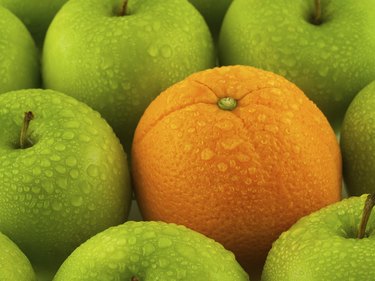
Americans consumed more oranges than any other fruit between 2000 and 2010, according to the USDA, and commercial growers produce 7,500 apple varieties, according to the University of Illinois Extension. Evaluating the value of the two fruits in the diet requires reviewing American dietary guidelines. The USDA recommends eating 2.5 servings daily. In 2005, only one out of every three Americans ate two or more servings of fruit each day, according to the Centers for Disease Control and Prevention. Consuming any type of fruit is beneficial, but if most Americans are consuming fewer than one serving daily, choosing the fruit with the healthiest nutrient content is important.
Calories
Video of the Day
The orange provides 85 calories, or 4 percent of the daily calories, based on a standard 2,000-calorie diet; the apple provides 57 calories, or 3 percent of the daily caloric intake. Fruit and vegetables often provide fewer calories compared with other food types that contain more energy-dense fat grams. Shifting concern to meat and dairy products is more beneficial for the weight-conscious consumer.
Video of the Day
Fiber
An orange provides 4.3 g of fiber, while an apple provides 2.6 g. The FDA recommends consuming foods that provide 25 g each day. Plant-based foods provide fiber in the diet. The USDA recommends consuming 5 to 9 total servings of fruits and vegetables each day. Meeting this recommendation along with grains and nuts is an easy-to-remember way to include an adequate amount of fiber in the diet. Fiber supports healthy digestion and clears excess cholesterol from the body. Including both the apple and the orange in the diet is beneficial for meeting the daily fiber requirement.
Vitamins
The orange and apple provide several vitamins, including vitamin C, folic acid and vitamin A. The daily requirement of vitamin C is 60 mg. The orange provides 95.8 mg. The apple provides 5 mg. The folic acid daily requirement is 400 micrograms. The orange provides 54 micrograms and the apple provides 3 micrograms. The vitamin A daily requirement is 5,000 IU. The orange provides 405 IU, and the apple provides 59 IU. Vitamins A and C and important antioxidants that protect healthy cells in the body from free radical damage. Folic acid is essential for the formation of DNA and cell splitting necessary for growth and development of infants and children. Including an orange in the diet provides a significant level of each vitamin that contributes to health.
Minerals
The minerals oranges and apples provide include calcium and potassium. Calcium and potassium both contribute to a healthy cardiovascular system because they regulate the contraction of the heart muscle. The 72 mg of calcium and 326 mg of potassium the orange provides is more significant compared with the 7 mg of calcium and 117 mg of potassium the apple provides. The daily requirements are 1,000 mg of calcium and 3,500 mg of potassium.
Apples or Oranges
The orange provides more vitamins, minerals and fiber compared with the apple. It also provides more calories, but the additional energy it provides in the diet is balanced by the additional nutrient benefits. Including both fruits in the diet is beneficial, but if choosing just one is required, the orange is a healthier selection.
- Centers for Disease Control and Prevention; Fruit and Vegetable Consumption Among Adults -- United States 2005; March 2007
- USDA: Nutrient Data Laboratory: Apples, Raw, With Skin
- MayoClinic.com; What Does Percent Daily Value Mean on Food Labels?; Katherine Zeratsky, R.D., L.D.; May 6, 2010
- Purdue University; Orange; J. Morton; April 2011
- University of Illinois Extension: Apples and More
- Purdue University; Orange; J. Morton; 1987